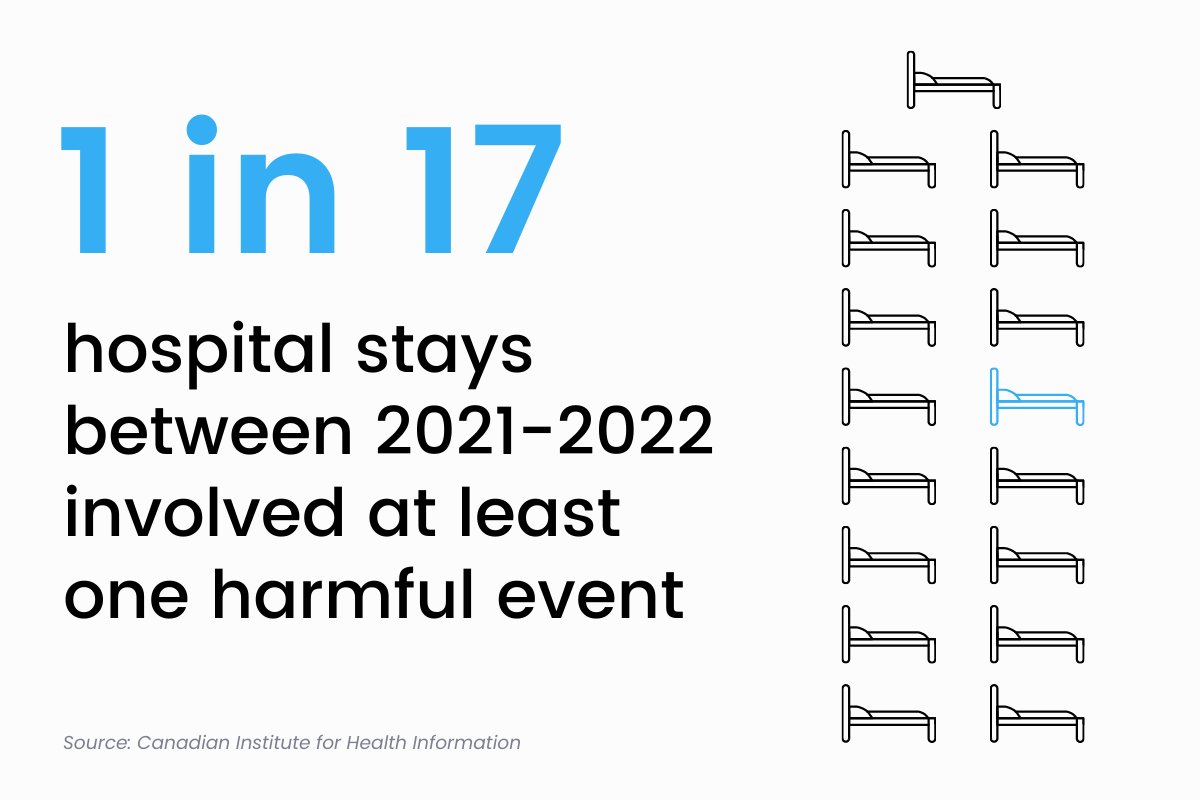3 min read
The Importance of Improving Patient Safety & Quality of Care
Performance Health Partners
June 19, 2023
Improving patient safety and ensuring the highest quality of care should be the foundation on which all healthcare strategies are built upon. These objectives are not only paramount to the wellbeing of each individual patient and healthcare worker, but they also significantly enhance the overall efficiency of the organization. By focusing on these two key aspects, we can create a healthcare environment that actively prevents medical errors, reduces healthcare costs, and, most importantly, improves patient outcomes.
The Current Landscape of Patient Safety and Quality of Care
Despite the vast resources directed towards improving safety in healthcare, recent data show that we’ve still got a long way to go. The Canadian Institute for Health Information found that in 2021, 1 out of 17 patients experienced preventable harm – such as medication errors, post-surgical infections, or falls – during their hospital stay.

Linda Aiken, a professor and the founding director of the Center for Health Outcomes and Policy Research at Penn Nursing, emphasized the integral role of staffing in patient safety. In an interview with NBC News, she affirmed, “Since we’ve been doing research on patient safety, we consistently find that one of the major explanations for poor patient outcomes is insufficient numbers of nurses at the bedside … Having a sufficient number of nurses is a building block for safety.”
This is especially concerning considering nearly a third of U.S. nurses say they will likely leave nursing for another career due to the strain the pandemic has imposed, a May 2023 survey found. This alarming figure points to a crippling nurse shortage in the U.S., with about 94% of the surveyed nurses reporting a moderate to severe shortage of nurses in their areas.
Moreover, the situation has taken a toll on how patients are cared for; the percentage of nurses who said they were satisfied with the quality of care they provide decreased from 75% in 2021 to 64% in 2023.
Some sectors of the health care industry plagued by significant labor shortages during the pandemic appear to be rebounding, but the survey suggests a shortage of nurses may continue to be a major challenge for health care providers for years to come. These figures underscore the magnitude of patient safety issues, painting a sobering picture that calls for urgent and targeted action.
At the center of improving patient safety outcomes is developing a culture of care where errors are less likely to happen, and when they do, they are promptly identified and corrected. A key patient safety initiative that facilitates this process is an incident reporting system in healthcare. When implemented correctly, an efficient incident reporting process contributes to a safe, blame-free environment where staff can report errors and near misses, providing crucial data for system improvement.
The Pillars of Improvement: Incident Reporting and Management
An effective incident management system enables the identification, reporting, and evaluation of incidents in a non-punitive manner. This leads to a culture of learning that embraces reporting, and encourages staff to share their observations around unsafe conditions so that they play an active role in preventing harm.
Benefits of an effective incident management system include:
- Enhanced transparency: Real-time tracking and reporting of incidents and other types of events such as near misses promote accountability and visibility across all healthcare processes.
- Improved learning: A streamlined process for capturing and analyzing events promotes learning and helps prevent similar incidents from reoccurring in the future.
- Risk management: An incident management system enables leaders to quickly identify and mitigate risks, promoting a safer healthcare environment for both patients and healthcare providers.
- Boosted employee engagement: A non-punitive system encourages transparency and trust, creating a positive work culture and strengthening team commitment towards patient safety.
- Increased efficiency: By understanding the root causes of incidents and taking corrective action to close process gaps, the system helps in improving overall care delivery, leading to operational efficiency.
The Path Forward: Enhancing Quality of Care
Improving quality of care goes hand in hand with patient safety. Providing the best possible care isn't just about preventing errors; it's about ensuring the right patient gets the right care at the right time. It involves all aspects of the healthcare delivery process, from initial diagnosis to the final treatment.
Key strategies to enhance quality of care include:
- Patient-centered care: The active involvement of patients in their treatment, care plans, and decision-making processes results in a more personalized care experience, which can lead to boosted patient satisfaction. By fostering open communication, healthcare providers can better understand the unique needs and preferences of patients, ultimately leading to an improved patient experience.
- Evidence-based practice: Utilizing the most recent scientific evidence and data-backed best practices to make healthcare decisions is paramount. This approach ensures that patients receive the best possible care, founded on rigorous research and clinical expertise, enhancing treatment efficacy and outcomes.
- Ongoing education and training: Consistent training of healthcare professionals maintains their competency, keeps them abreast of developing healthcare trends, and equips them with the skills needed to provide the best possible care.
- Integrated care: By integrating care across all departments and providers, we can prevent unnecessary duplication of services, improve resource utilization, and enhance patient outcomes. It enables seamless transitions between different care settings, leading to comprehensive, coordinated care.
Improving Patient Safety and Quality of Care is Everyone's Responsibility
Improving patient safety and quality of care is a collective responsibility that requires participation of all stakeholders, from patients and providers to organizations and policymakers.
In an age when healthcare is becoming increasingly complex, prioritizing patient safety and improving the quality of care is more crucial than ever. By employing a robust incident reporting system, fostering a culture of safety, and constantly striving for quality, we can ensure that our healthcare system isn’t only efficient and effective, but also patient-centered and safe.
To this end, it is everyone’s role to enhance patient safety and the quality of care. It's not only a moral and professional obligation; it’s the best way forward to a healthier and safer future for all.


